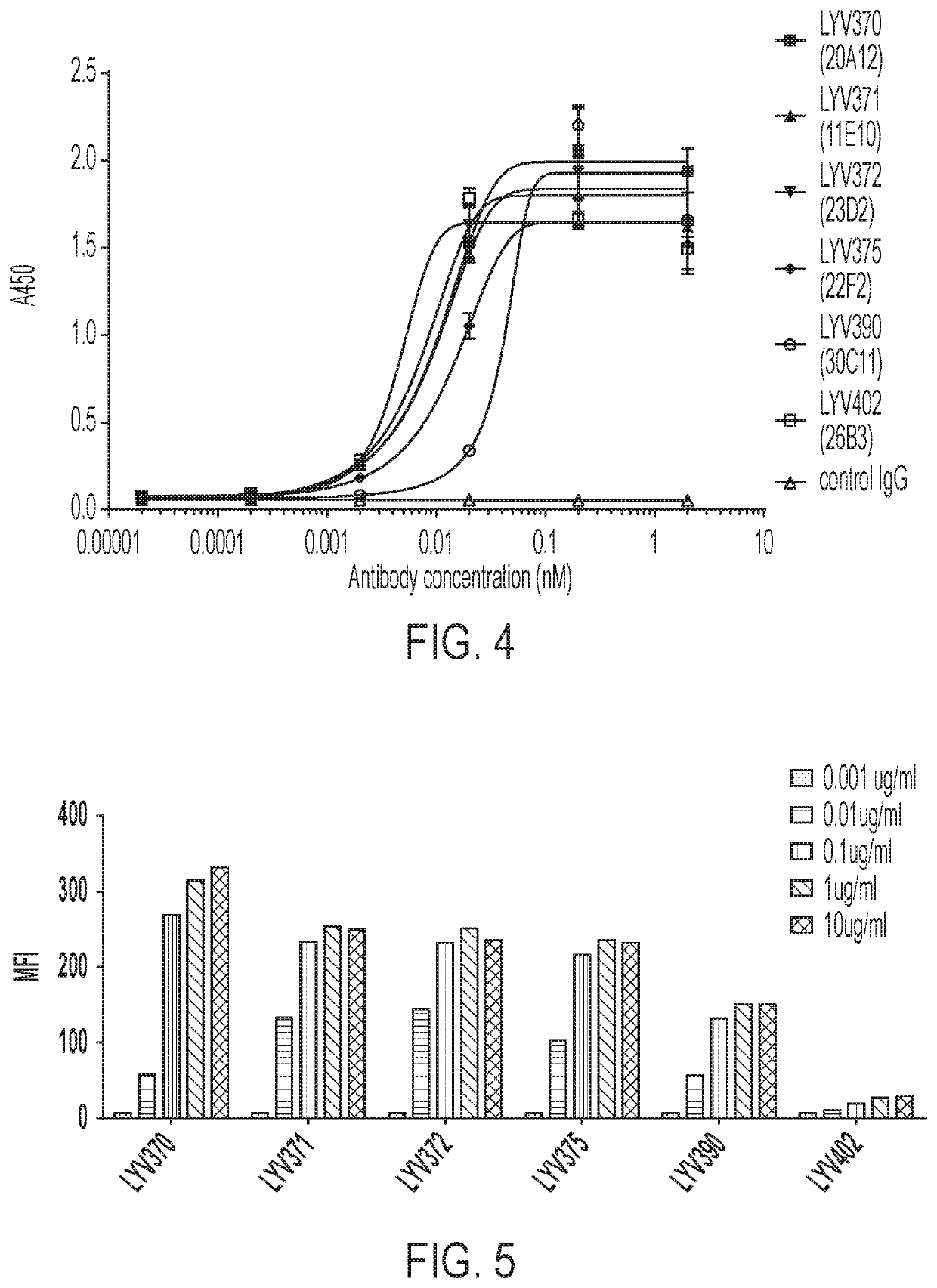Anti-cd137 antibodies and uses thereof
a technology of anti-cd137 and antibodies, which is applied in the field of anti-cd137 antibodies, can solve the problems that agonist antibodies specific to cd137 have also been reported to induce significant liver toxicity in patients, and achieve superior anti-tumor effects, potent immune cell activity, and affinity high
- Summary
- Abstract
- Description
- Claims
- Application Information
AI Technical Summary
Benefits of technology
Problems solved by technology
Method used
Image
Examples
example 1
n of Anti-CD137 Antibodies
Reagents and General Methods
[0147]Human CD137 / 4-1BB / TNFRSF9 protein (cat #838-4B, Fc chimera) and human 4-1BB / TNFRSF9 MAb (Clone 145501, mouse IgG2B, cat #MAB838) were purchased from R&D Systems (USA). A stable CHO cell line expressing human or cynomolgus monkey CD137 was developed by transfection with full length human CD137 cDNA (Gene ID: 3604) or cynomolgus monkey CD137 cDNA (Gene ID: 102127961).
[0148]A standard ELISA was used to detect anti-CD137 antibodies. Plates were coated with CD137 protein and incubated with anti-CD137 antibodies. The antibody molecules bound to CD137 were detected using secondary antibodies (goat anti-mouse or rat IgG) conjugated with peroxidase.
[0149]FACS was performed to detect anti-CD137 antibodies using the CHO-CD137 cell line. After a period of incubation with antibody samples, CHO-CD137 cells were analyzed by commercially available PE- or FITC-labeled secondary antibodies using FACS.
Hybridoma Development and Lead Antibody I...
example 2
n of Anti-CD137 Chimeric Antibodies
KD Measurement of CD137 Antigen Binding
[0155]The chimeric antibodies were tested in an antigen binding assay on Octet Red 96 to estimate binding kinetics. Antibodies were loaded onto anti-human Fc (AHC) biosensors. Loaded sensors were dipped into a serial dilution of each antibody (300 nM, 1:3 down, 7 points) in assay buffer (PBS with 0.1% BSA, 0.02% Tween-20 (pH 7.2)). Kinetic constants calculated using a monovalent (1:1) model are shown in Table 1 below.
TABLE 1Kinetic Constants of Chimeric AntibodiesAntibodiesKD(M)kon(1 / Ms)kdis(1 / s)LYV370 (20A12-IgG4)5.70E−091.80E+051.00E−03LYV371 (11E10-IgG4)3.80E−092.80E+051.10E−03LYV372 (23D2-IgG4)5.80E−092.80E+051.60E−03LYV375 (22F2-IgG4)8.20E−092.80E+052.30E−03LYV390 (30C11-IgG4)5.30E−092.60E+051.40E−03LYV402 (26B3-IgG4)2.10E−091.60E+053.40E−04
CD137 Binding ELISA
[0156]CD137 protein (human CD137-His tag protein (Sino Biological Inc. Cat #10377-H08H-100) or rhesus monkey CD137-His (Sino Biological Inc. Cat #90...
example 3
inetic Study of Chimeric Antibodies
[0160]C57BL / 6 mice (6-7 weeks old, 19-20 g, male, purchased from SLAC Laboratory Animal Co. LTD) were used for the study. Antibodies were formulated in PBS and administered via tail vein injection at 3 mg / kg in a group of 4 mice.
[0161]Blood sampling was done at pre-dose, 1 h, 2 h, 4 h, 8 h, 1 d, 2 d, 3 d, 5 d, 8 d, 11 d, 15 d and 21 d by serial bleeding. 10 uL blood per time point was added to 40 uL of a PBS-BSA solution. The sample was then mixed well and centrifuged at 2000 g for 5 minutes at 4° C. The supernatant was put on dry ice immediately after collection and stored at approximately −70° C. until analysis. Blood antibody concentrations were determined by ELISA as described in section above. FIG. 8 shows the blood antibody concentration of chimeric antibodies after a single intravenous injection of 3 mg / kg.
PUM
| Property | Measurement | Unit |
|---|---|---|
| Length | aaaaa | aaaaa |
| Light | aaaaa | aaaaa |
Abstract
Description
Claims
Application Information
 Login to View More
Login to View More - R&D Engineer
- R&D Manager
- IP Professional
- Industry Leading Data Capabilities
- Powerful AI technology
- Patent DNA Extraction
Browse by: Latest US Patents, China's latest patents, Technical Efficacy Thesaurus, Application Domain, Technology Topic, Popular Technical Reports.
© 2024 PatSnap. All rights reserved.Legal|Privacy policy|Modern Slavery Act Transparency Statement|Sitemap|About US| Contact US: help@patsnap.com










